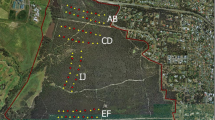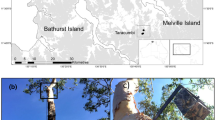Abstract
In Australia, brushtail possums (Trichosurus vulpecula) are declining in natural habitats but have adapted to urban environments so readily that some human residents consider them to be a nuisance. Although this situation represents a conundrum for management, the use of urban habitats by the species remains poorly studied. We conducted our study in six urban parklands, a setting that represents an intermediary between a fully-urban and fully-natural environment. To determine factors that influence the presence of hollows in trees and their use by brushtail possums, physical characteristics of 240 mature trees in six parks in the Adelaide Parklands, South Australia were assessed. To investigate hollow use more comprehensively, 18 possums were radio-tracked. Presence of hollows in trees was a function of tree species and tree size, with hollows formed in both exotic and native species. Tree form and number of hollows were significant predictors of the use of hollow-bearing trees by possums. Use of exotic trees was high, with only 34 % of recorded den trees being native (non-indigenous) species. Radio-tracked individuals were relatively sedentary, with an average daytime denning area of 0.08 ha. While the majority of animals used multiple den sites, all individuals favoured a single den. Use of a variety of anthropogenic structures was high, even when trees were available. On average, sites supported ~1.5 brushtail possums per hollow-bearing tree. A correlation between number of hollows per hectare and possum density (r =0.892, P =0.017) suggests that altering a given area’s density of hollows or anthropogenic structures could influence the density of possums within it.




Similar content being viewed by others
References
Bennett AF, Lumsden LF, Nicholls AO (1994) Tree hollows as a resource for wildlife in remnant woodlands: spatial and temporal patterns across the northern plains of Victoria, Australia. Pac Conserv Biol 1:225–235
Caley P, Spencer NJ, Cole RA, Efford MG (1998) The effect of manipulating population density on the probability of den-sharing among common brushtail possums, and the implications for transmission of bovine tuberculosis. Wildl Res 25:383–392. doi:10.1071/WR97029
Chace JF, Walsh JJ (2006) Urban effects on native avifauna: a review. Landsc Urban Plan 74:46–69
Cowan PE (1990) Brushtail possum. In: King CM (ed) The handbook of New Zealand mammals. Oxford University Press, Auckland, New Zealand, pp 68–98
Dearborn DC, Kark S (2010) Motivations for conserving urban biodiversity. Conserv Biol 24:432–440
Eymann J, Cooper DW, Herbert CA (2013) Brushtail possums (Trichosurus vulpecula) in metropolitan Sydney: population biology and response to Suprelorin contraceptive implants. Aust J Zool 61:78–86
Eyre T (2004) Distribution and conservation status of the possums and gliders of southern Queensland. In: Goldingay RL, Jackson SM (eds) The biology of Australian possums and gliders. Surrey Beatty & Sons Pty Ltd, Chipping Norton, NSW, pp 1–25
Fairweather AAC, Brockie RE, Ward GD (1987) Possums (Trichosurus vulpecula) sharing dens: a potential infection route for bovine tuberculosis. New Z Vet J 35:15–16
Gibbons P, Lindenmayer DB (2002) Tree hollows and wildlife conservation in Australia. CSIRO Publishing, Melbourne, Victoria
Goldingay RL, Jackson SM (eds) (2004) The biology of Australian possums and gliders. Surrey Beatty & Sons Pty Limited, Chipping Norton, New South Wales
Green W, Coleman J (1987) Den sites of possums, Trichosurus vulpecula, and frequency of use in mixed hardwood forest in Westland, New Zealand. Wildl Res 14:285–292. doi:10.1071/WR9870285
Handasyde KA (1997) The ringtail and brushtail possum populations at Melbourne Zoo. Research for management. Internal report, Melbourne Zoo, Melbourne, Victoria, Australia
Harper MJ (2005) Home range and den use of common brushtail possums (Trichosurus vulpecula) in urban forest remnants. Wildl Res 32:681–687. doi:10.1071/WR04072
Harris S, Cresswell WJ, Forde PG, Trewhella WJ, Woollard T, Wray S (1990) Home range analysis using radio-tracking data - a review of problems and techniques particularly as applied to the study of mammals. Mamm Rev 20:97–103
Hill B (1996) The ecology and management of the common brush-tailed possum in the Adelaide metropolitan region. University of Adelaide, Adelaide
Hill NJ, Carbery KA, Deane EM (2007) Human-possum conflict in urban Sydney, Australia: public perceptions and implications for species management. Hum Dimens Wildl 12:101–113
How RA (1981) Population parameters of two congeneric possums, Trichosurus spp., in north-eastern New South Wales. Aust J Zool 29:205–215
How RA, Hillcox SJ (2000) Brushtail possum, Trichosurus vulpecula, populations in south-western Australia: demography, diet and conservation status. Wildl Res 27:81–89. doi:10.1071/WR98064
Inions G, Tanton M, Davey S (1989) Effect of fire on the availability of hollows in trees used by the common brushtail possum, Trichosurus vulpecula Kerr, 1792, and the ringtail possum, Pseudocheirus peregrinus Boddaerts, 1785. Wildl Res 16:449–458. doi:10.1071/WR9890449
Isaac JL (2005) Life history and demographics of an island possum. Aust J Zool 53:195–203
Ji W, Sarre SD, Craig JL, Clout MN (2003) Denning behavior of common brushtail possums in populations recovering from density reduction. J Mamm 84:1059–1067
Johnson CN, Clinchy M, Taylor AC, Krebs CJ, Jarman PJ, Payne A, Ritchie EG (2001) Adjustment of offspring sex ratios in relation to the availability of resources for philopatric offspring in the common brushtail possum. Proc R Soc Lond B Biol Sci 268:2001–2005
Kerle JA (1998) The population dynamics of a tropical possum, Trichosurus vulpecula arnhemensis Collett. Wildl Res 25:171–181
Kerle JA (2001) Possums: The brushtails, ringtails and greater glider. Australian Natural History Series. University of New South Wales Press Ltd, Sydney, Australia
Kerle JA, Foulkes JN, Kimber RG, Papenfus D (1992) The decline of the brushtail possum, Trichosurus vulpecula (Kerr 1798), in arid Australia. Rangel J 14:107–127
Lindenmayer D, Cunningham RB, Donelley CF, Tanton MT, Nix HA (1993) The abundance and development of cavities in Eucalyptus trees: a case study in the montane forests of Victoria, southeastern Australia. For Ecol Manag 60:77–104
Lindenmayer D, Cunningham RB, Tanton MT, Smith AP, Nix HA (1990) The conservation of arboreal marsupials in the montane ash forest of the central highlands of Victoria, south-east Australia: I. Factors influencing the occupancy of trees with hollows. Biol Conserv 54:111–131
Lindenmayer D, Welsh A, Donelley C, Meggs R (1996a) Use of nest trees by the mountain brushtail possum (Trichosurus caninus) (Phalangeridae: Marsupialia). I. Number of occupied trees and frequency of tree use. Wildl Res 23:343–361. doi:10.1071/WR9960343
Lindenmayer DB, Cunningham RB, Pope ML, Gibbons P, Donnelly CF (2000) Cavity sizes and types in Australian eucalypts from wet and dry forest types - a simple rule of thumb for estimating size and number of cavities. For Ecol Manag 137:139–150
Lindenmayer DB, Cunningham RB, Tanton MT, Smith AP, Nix HA (1991a) Characteristics of hollow-bearing trees occupied by arboreal marsupials in the montane ash forests of the Central Highlands of Victoria, south-east Australia. For Ecol Manag 40:289–308. doi:10.1016/0378-1127(91)90047-Y
Lindenmayer DB, Nix HA, Cunningham RB, Tanton MT, Smith AP (1991b) Predicting the abundance of hollow-bearing trees in montane forests of southeastern Australia. Aust J Ecol 16:91–98
Lindenmayer DB, Welsh A, Donnelly C, Cunningham RB (1996b) The use of nest trees by the mountain brushtail possum (Trichosurus caninus) (Phalangeridae: Marsupialia). II. The characteristics of occupied trees. Wildl Res 23:531–545
Long M (2003) A biodiversity survey of the Adelaide Parklands, South Australia in 2003. Department for Environment and Heritage, Adelaide, Australia
Lowry H, Lill A, Wong BBM (2013) Behavioural responses of wildlife to urban environments. Biol Rev 88:537–549
Lunney D, Burgin S (2004) Urban wildlife management: an emerging discipline. In: Lunney D, Burgin S (eds) Urban wildlife: more than meets the eye. Royal Zoological Society of New South Wales, Mosman, NSW, pp 1–7
Magle SB, Hunt VM, Vernon M, Crooks KR (2012) Urban wildlife research: past, present, and future. Biol Conserv 155:23–32
Matthews A, Lunney D, Waples K, Hardy J (2004) Brushtail Possums: "Champion of the suburbs" or "Our tormentors"? In: Lunney D, Burgin S (eds) Urban wildlife: more than meets the eye. Royal Zoological Society of New South Wales, Mosman, NSW, pp 159–168
McCullagh P, Nelder JA (1983) Generalised linear models. Chapman and Hall, New York, USA
McKinney ML (2006) Urbanization as a major cause of biotic homogenization. Biol Conserv 127:247–260
Montague TL (ed) (2000) The brushtail possum. Biology, impact and management of an introduced marsupial. Manaaki Whenua Press, Lincoln, New Zealand
Patt M (1995) The free-ranging population of the brush-tail possum, Trichosurus vulpecula Kerr, in the urban environment of the Perth Zoo: population estimates and management implications. Dissertation (Honours), Edith Cowan University
Pietsch RS (1994) The ecology and translocation of urban common brushtail possums. Dissertation (M.Sc.), Deakin University
Ramsey D, Efford MG, Cowan PE, Coleman JD (2002) Factors influencing annual variation in breeding by common brushtail possums (Trichosurus vulpecula) in New Zealand. Wildl Res 29:39–50
Russell TC, Herbert CA, Kohen JL, Cooper DW (2013) The incidence of road-killed possums in the Ku-ring-gai area of Sydney. Aust J Zool 61:87–94
Seebeck J, Suckling G, Macfarlane M (1983) Leadbeater's possum - survey by stagwatching. Vic Nat 100:92–97
Smith AP, Lindenmayer DB (1988) Tree hollow requirements of Leadbeater's possum and other possums and gliders in timber production ash forests of the Victorian Central Highlands. Aust Wildl Res 16:575–580
Statham M, Statham HL (1997) Movements and habits of brushtail possums (Kerr) in an urban area. Wildl Res 24:715–726. doi:10.1071/WR96092
Stow AJ, Minarovic N, Eymann J, Cooper DW, Webley LS (2006) Genetic structure infers generally high philopatry and male-biased dispersal of brushtail possums (Trichosurus vulpecula) in urban Australia. Wildl Res 33:409–415. doi:10.1071/WR06019
United Nations Population Fund (2007) State of the world population: unleashing the potential of urban growth. United Nations Population Fund, New York, USA
van der Ree R, McCarthy MA (2006) Inferring persistence of indigenous mammals in response to urbanisation. Anim Conserv 8:309–319
van der Ree R, Ward SJ, Handasyde KA (2004) Distribution and conservation status of possums and gliders in Victoria. In: Goldingay RL, Jackson SM (eds) The biology of Australian possums and gliders. Surrey Beatty & Sons Pty Ltd, Chipping Norton, NSW, pp 91–110
Van Dyck S, Strahan R (eds) (2008) The mammals of Australia. Reed New Holland Publishers, Sydney, Australia
Wilson G (1998) Effects of sterilisation of females on the nightly home range and denning behaviours of brushtail possums (Trichosurus vulpecula). Dissertation (M.Sc.), University of Auckland
Winter JW (1976) The behaviour and social organisation of the brush-tail possum (Trichosurus vulpecula Kerr). Dissertation (Ph.D.), University of Queensland
Wood MS, Wallis RL (1998) Potential competition for nest sites between feral European honeybees (Apis melifera) and common brushtail possums (Trichosurus vulpecula). Aust Mamm 20:377–381
Acknowledgments
B-M Yáñez conducted the fieldwork whilst holding an Adelaide Priority (Honours) Scholarship from the University of Adelaide. Project funding was provided by Biocity – the Centre for Urban Habitats (University of Adelaide and UniSA). Work was conducted under a research permit (M25138-1) from the South Australian Department for Environment and Heritage and with approval from the University of Adelaide’s Animal Ethics Committee (AEC S-25-06). We wish to thank Greg Johnston and Chris Daniels for their advice, staff from both the Adelaide City Council and Adelaide Zoo for their support, and Kate Dowling from Biometrics SA for her help with statistical analyses. The assistance of all fieldwork volunteers, including those from Conservation Volunteers Australia, is also gratefully acknowledged.
Author information
Authors and Affiliations
Corresponding author
Rights and permissions
About this article
Cite this article
Carthew, S.M., Yáñez, BM. & Ruykys, L. Straddling the divide: den use by brushtail possums (Trichosurus vulpecula) in urban parklands. Urban Ecosyst 18, 525–538 (2015). https://doi.org/10.1007/s11252-014-0420-x
Published:
Issue Date:
DOI: https://doi.org/10.1007/s11252-014-0420-x




